Exploring Theories of Learning, Communication, and Assessment
VerifiedAdded on 2022/08/14
|10
|2928
|32
Essay
AI Summary
This essay comprehensively examines various theories and models crucial to education. It begins by exploring three prominent learning theories: behaviorism, cognitivism, and constructivism, along with learning preference theories like VARK and Honey & Mumford. The essay then delves into communication theories, including the Shannon and Weaver model, Burlo's model, transactional analysis, and Osgood-Schramm's model, highlighting their applications and critiques. Furthermore, it analyzes assessment methods, differentiating between assessment for and of learning, and discussing criterion-referenced and norm-referenced tests, along with the VACSR principles. The paper also covers curriculum planning models, such as product and process models, and the Tyler Model, before concluding with a discussion on reflective practice, exploring Brookfield's theory and Kolb's and Gibbs' reflective models. The essay provides insights into how these theories and models can be applied in educational settings to enhance learning and teaching effectiveness.
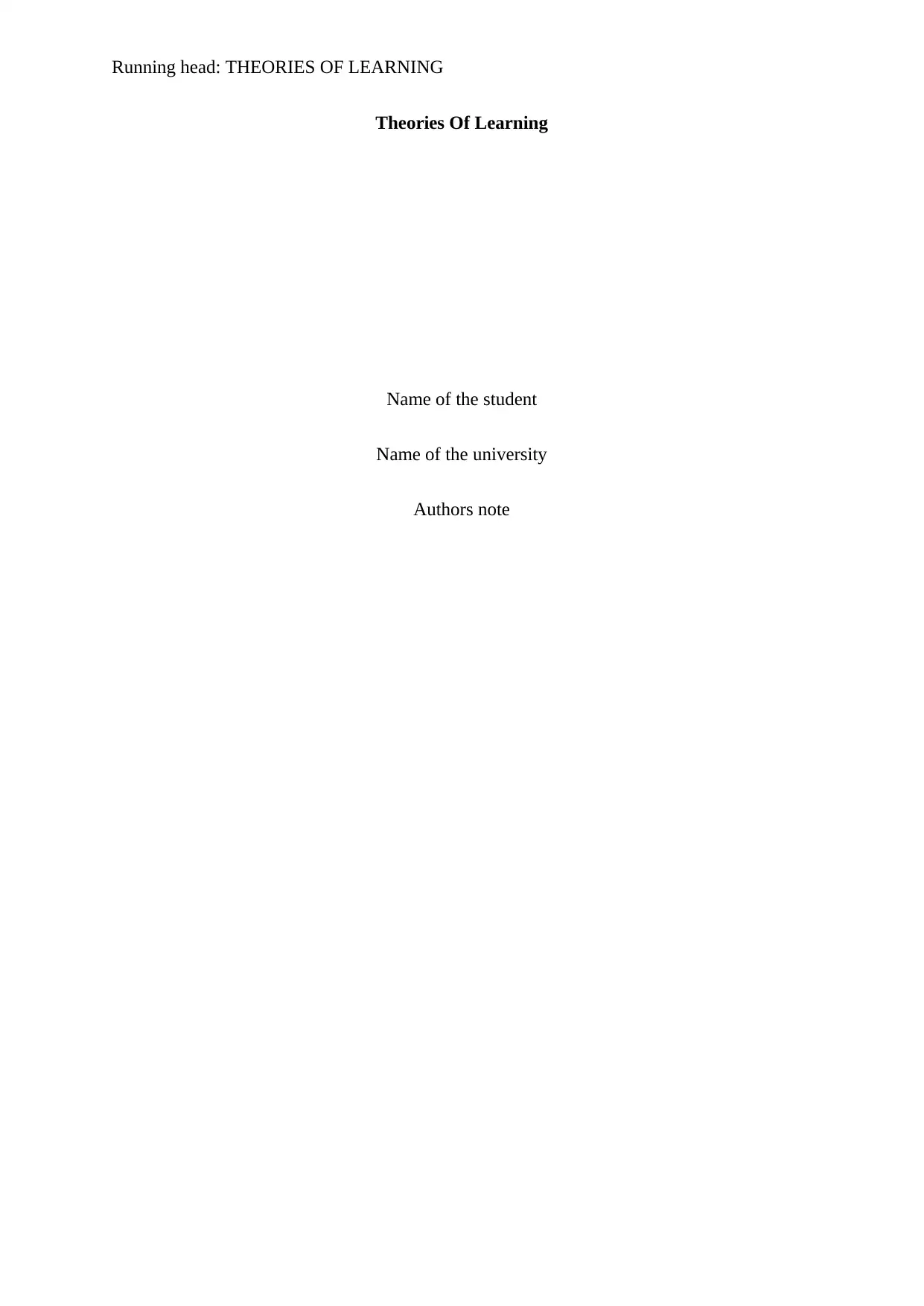
Running head: THEORIES OF LEARNING
Theories Of Learning
Name of the student
Name of the university
Authors note
Theories Of Learning
Name of the student
Name of the university
Authors note
Paraphrase This Document
Need a fresh take? Get an instant paraphrase of this document with our AI Paraphraser
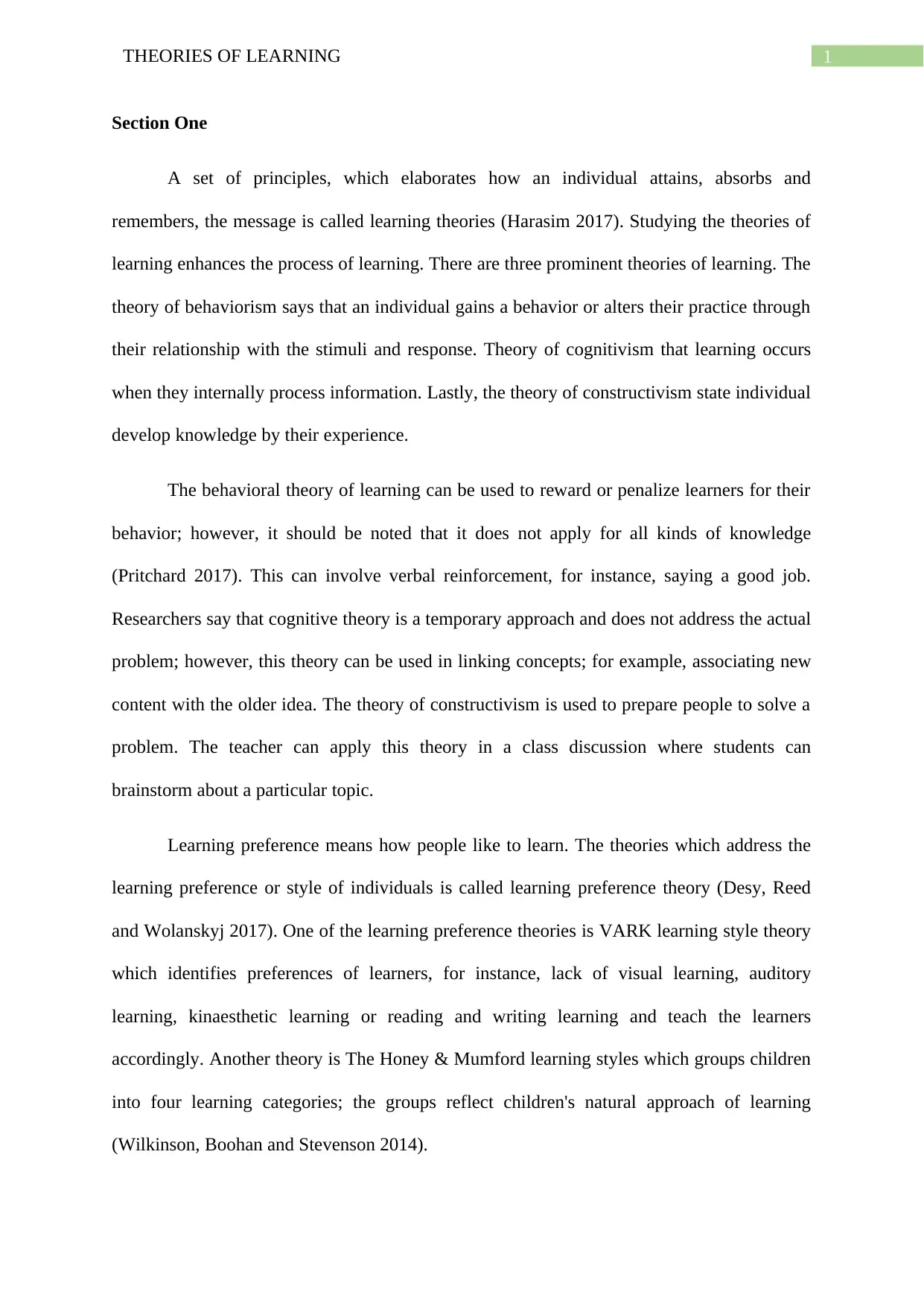
1THEORIES OF LEARNING
Section One
A set of principles, which elaborates how an individual attains, absorbs and
remembers, the message is called learning theories (Harasim 2017). Studying the theories of
learning enhances the process of learning. There are three prominent theories of learning. The
theory of behaviorism says that an individual gains a behavior or alters their practice through
their relationship with the stimuli and response. Theory of cognitivism that learning occurs
when they internally process information. Lastly, the theory of constructivism state individual
develop knowledge by their experience.
The behavioral theory of learning can be used to reward or penalize learners for their
behavior; however, it should be noted that it does not apply for all kinds of knowledge
(Pritchard 2017). This can involve verbal reinforcement, for instance, saying a good job.
Researchers say that cognitive theory is a temporary approach and does not address the actual
problem; however, this theory can be used in linking concepts; for example, associating new
content with the older idea. The theory of constructivism is used to prepare people to solve a
problem. The teacher can apply this theory in a class discussion where students can
brainstorm about a particular topic.
Learning preference means how people like to learn. The theories which address the
learning preference or style of individuals is called learning preference theory (Desy, Reed
and Wolanskyj 2017). One of the learning preference theories is VARK learning style theory
which identifies preferences of learners, for instance, lack of visual learning, auditory
learning, kinaesthetic learning or reading and writing learning and teach the learners
accordingly. Another theory is The Honey & Mumford learning styles which groups children
into four learning categories; the groups reflect children's natural approach of learning
(Wilkinson, Boohan and Stevenson 2014).
Section One
A set of principles, which elaborates how an individual attains, absorbs and
remembers, the message is called learning theories (Harasim 2017). Studying the theories of
learning enhances the process of learning. There are three prominent theories of learning. The
theory of behaviorism says that an individual gains a behavior or alters their practice through
their relationship with the stimuli and response. Theory of cognitivism that learning occurs
when they internally process information. Lastly, the theory of constructivism state individual
develop knowledge by their experience.
The behavioral theory of learning can be used to reward or penalize learners for their
behavior; however, it should be noted that it does not apply for all kinds of knowledge
(Pritchard 2017). This can involve verbal reinforcement, for instance, saying a good job.
Researchers say that cognitive theory is a temporary approach and does not address the actual
problem; however, this theory can be used in linking concepts; for example, associating new
content with the older idea. The theory of constructivism is used to prepare people to solve a
problem. The teacher can apply this theory in a class discussion where students can
brainstorm about a particular topic.
Learning preference means how people like to learn. The theories which address the
learning preference or style of individuals is called learning preference theory (Desy, Reed
and Wolanskyj 2017). One of the learning preference theories is VARK learning style theory
which identifies preferences of learners, for instance, lack of visual learning, auditory
learning, kinaesthetic learning or reading and writing learning and teach the learners
accordingly. Another theory is The Honey & Mumford learning styles which groups children
into four learning categories; the groups reflect children's natural approach of learning
(Wilkinson, Boohan and Stevenson 2014).
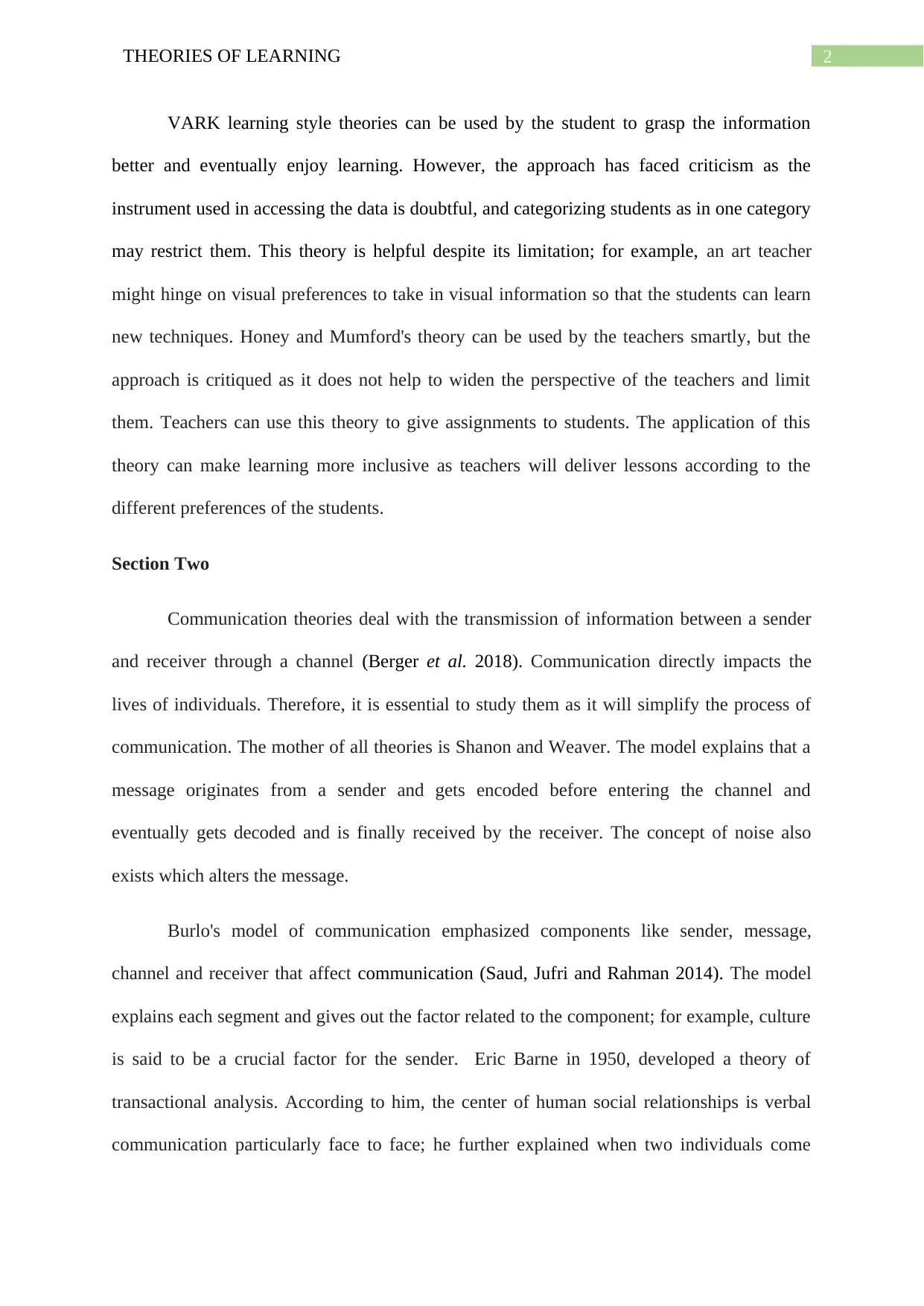
2THEORIES OF LEARNING
VARK learning style theories can be used by the student to grasp the information
better and eventually enjoy learning. However, the approach has faced criticism as the
instrument used in accessing the data is doubtful, and categorizing students as in one category
may restrict them. This theory is helpful despite its limitation; for example, an art teacher
might hinge on visual preferences to take in visual information so that the students can learn
new techniques. Honey and Mumford's theory can be used by the teachers smartly, but the
approach is critiqued as it does not help to widen the perspective of the teachers and limit
them. Teachers can use this theory to give assignments to students. The application of this
theory can make learning more inclusive as teachers will deliver lessons according to the
different preferences of the students.
Section Two
Communication theories deal with the transmission of information between a sender
and receiver through a channel (Berger et al. 2018). Communication directly impacts the
lives of individuals. Therefore, it is essential to study them as it will simplify the process of
communication. The mother of all theories is Shanon and Weaver. The model explains that a
message originates from a sender and gets encoded before entering the channel and
eventually gets decoded and is finally received by the receiver. The concept of noise also
exists which alters the message.
Burlo's model of communication emphasized components like sender, message,
channel and receiver that affect communication (Saud, Jufri and Rahman 2014). The model
explains each segment and gives out the factor related to the component; for example, culture
is said to be a crucial factor for the sender. Eric Barne in 1950, developed a theory of
transactional analysis. According to him, the center of human social relationships is verbal
communication particularly face to face; he further explained when two individuals come
VARK learning style theories can be used by the student to grasp the information
better and eventually enjoy learning. However, the approach has faced criticism as the
instrument used in accessing the data is doubtful, and categorizing students as in one category
may restrict them. This theory is helpful despite its limitation; for example, an art teacher
might hinge on visual preferences to take in visual information so that the students can learn
new techniques. Honey and Mumford's theory can be used by the teachers smartly, but the
approach is critiqued as it does not help to widen the perspective of the teachers and limit
them. Teachers can use this theory to give assignments to students. The application of this
theory can make learning more inclusive as teachers will deliver lessons according to the
different preferences of the students.
Section Two
Communication theories deal with the transmission of information between a sender
and receiver through a channel (Berger et al. 2018). Communication directly impacts the
lives of individuals. Therefore, it is essential to study them as it will simplify the process of
communication. The mother of all theories is Shanon and Weaver. The model explains that a
message originates from a sender and gets encoded before entering the channel and
eventually gets decoded and is finally received by the receiver. The concept of noise also
exists which alters the message.
Burlo's model of communication emphasized components like sender, message,
channel and receiver that affect communication (Saud, Jufri and Rahman 2014). The model
explains each segment and gives out the factor related to the component; for example, culture
is said to be a crucial factor for the sender. Eric Barne in 1950, developed a theory of
transactional analysis. According to him, the center of human social relationships is verbal
communication particularly face to face; he further explained when two individuals come
⊘ This is a preview!⊘
Do you want full access?
Subscribe today to unlock all pages.

Trusted by 1+ million students worldwide
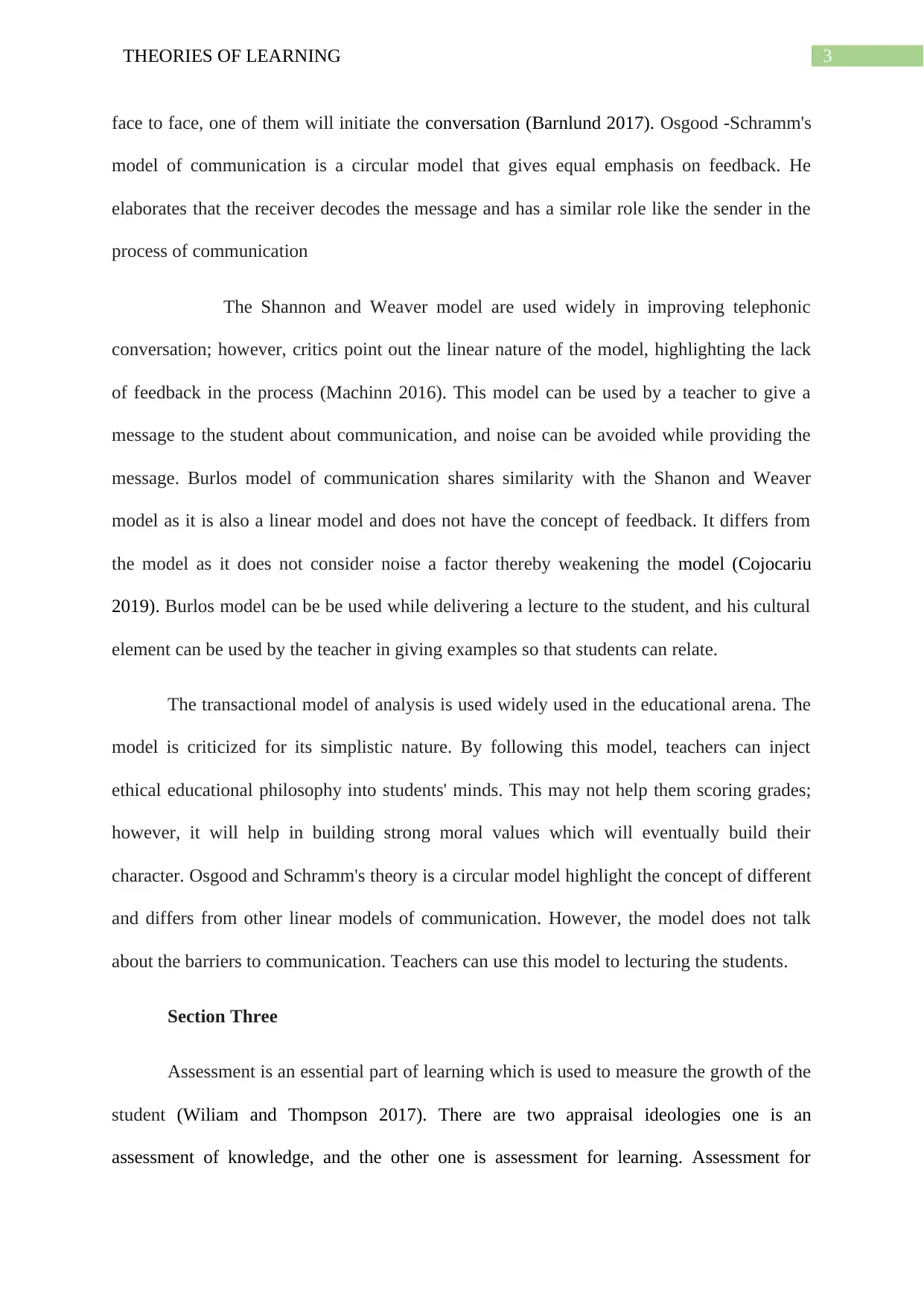
3THEORIES OF LEARNING
face to face, one of them will initiate the conversation (Barnlund 2017). Osgood -Schramm's
model of communication is a circular model that gives equal emphasis on feedback. He
elaborates that the receiver decodes the message and has a similar role like the sender in the
process of communication
The Shannon and Weaver model are used widely in improving telephonic
conversation; however, critics point out the linear nature of the model, highlighting the lack
of feedback in the process (Machinn 2016). This model can be used by a teacher to give a
message to the student about communication, and noise can be avoided while providing the
message. Burlos model of communication shares similarity with the Shanon and Weaver
model as it is also a linear model and does not have the concept of feedback. It differs from
the model as it does not consider noise a factor thereby weakening the model (Cojocariu
2019). Burlos model can be be used while delivering a lecture to the student, and his cultural
element can be used by the teacher in giving examples so that students can relate.
The transactional model of analysis is used widely used in the educational arena. The
model is criticized for its simplistic nature. By following this model, teachers can inject
ethical educational philosophy into students' minds. This may not help them scoring grades;
however, it will help in building strong moral values which will eventually build their
character. Osgood and Schramm's theory is a circular model highlight the concept of different
and differs from other linear models of communication. However, the model does not talk
about the barriers to communication. Teachers can use this model to lecturing the students.
Section Three
Assessment is an essential part of learning which is used to measure the growth of the
student (Wiliam and Thompson 2017). There are two appraisal ideologies one is an
assessment of knowledge, and the other one is assessment for learning. Assessment for
face to face, one of them will initiate the conversation (Barnlund 2017). Osgood -Schramm's
model of communication is a circular model that gives equal emphasis on feedback. He
elaborates that the receiver decodes the message and has a similar role like the sender in the
process of communication
The Shannon and Weaver model are used widely in improving telephonic
conversation; however, critics point out the linear nature of the model, highlighting the lack
of feedback in the process (Machinn 2016). This model can be used by a teacher to give a
message to the student about communication, and noise can be avoided while providing the
message. Burlos model of communication shares similarity with the Shanon and Weaver
model as it is also a linear model and does not have the concept of feedback. It differs from
the model as it does not consider noise a factor thereby weakening the model (Cojocariu
2019). Burlos model can be be used while delivering a lecture to the student, and his cultural
element can be used by the teacher in giving examples so that students can relate.
The transactional model of analysis is used widely used in the educational arena. The
model is criticized for its simplistic nature. By following this model, teachers can inject
ethical educational philosophy into students' minds. This may not help them scoring grades;
however, it will help in building strong moral values which will eventually build their
character. Osgood and Schramm's theory is a circular model highlight the concept of different
and differs from other linear models of communication. However, the model does not talk
about the barriers to communication. Teachers can use this model to lecturing the students.
Section Three
Assessment is an essential part of learning which is used to measure the growth of the
student (Wiliam and Thompson 2017). There are two appraisal ideologies one is an
assessment of knowledge, and the other one is assessment for learning. Assessment for
Paraphrase This Document
Need a fresh take? Get an instant paraphrase of this document with our AI Paraphraser
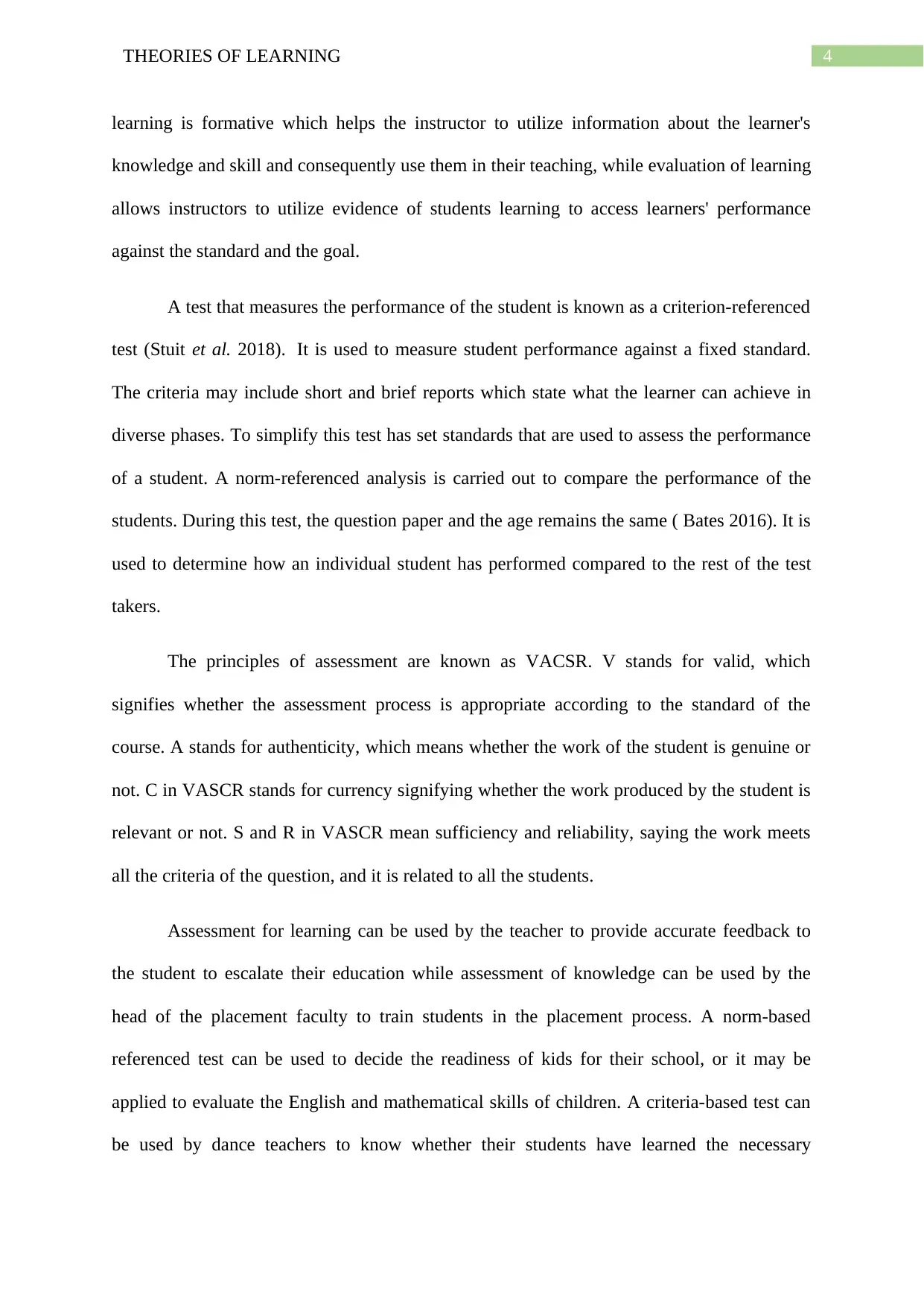
4THEORIES OF LEARNING
learning is formative which helps the instructor to utilize information about the learner's
knowledge and skill and consequently use them in their teaching, while evaluation of learning
allows instructors to utilize evidence of students learning to access learners' performance
against the standard and the goal.
A test that measures the performance of the student is known as a criterion-referenced
test (Stuit et al. 2018). It is used to measure student performance against a fixed standard.
The criteria may include short and brief reports which state what the learner can achieve in
diverse phases. To simplify this test has set standards that are used to assess the performance
of a student. A norm-referenced analysis is carried out to compare the performance of the
students. During this test, the question paper and the age remains the same ( Bates 2016). It is
used to determine how an individual student has performed compared to the rest of the test
takers.
The principles of assessment are known as VACSR. V stands for valid, which
signifies whether the assessment process is appropriate according to the standard of the
course. A stands for authenticity, which means whether the work of the student is genuine or
not. C in VASCR stands for currency signifying whether the work produced by the student is
relevant or not. S and R in VASCR mean sufficiency and reliability, saying the work meets
all the criteria of the question, and it is related to all the students.
Assessment for learning can be used by the teacher to provide accurate feedback to
the student to escalate their education while assessment of knowledge can be used by the
head of the placement faculty to train students in the placement process. A norm-based
referenced test can be used to decide the readiness of kids for their school, or it may be
applied to evaluate the English and mathematical skills of children. A criteria-based test can
be used by dance teachers to know whether their students have learned the necessary
learning is formative which helps the instructor to utilize information about the learner's
knowledge and skill and consequently use them in their teaching, while evaluation of learning
allows instructors to utilize evidence of students learning to access learners' performance
against the standard and the goal.
A test that measures the performance of the student is known as a criterion-referenced
test (Stuit et al. 2018). It is used to measure student performance against a fixed standard.
The criteria may include short and brief reports which state what the learner can achieve in
diverse phases. To simplify this test has set standards that are used to assess the performance
of a student. A norm-referenced analysis is carried out to compare the performance of the
students. During this test, the question paper and the age remains the same ( Bates 2016). It is
used to determine how an individual student has performed compared to the rest of the test
takers.
The principles of assessment are known as VACSR. V stands for valid, which
signifies whether the assessment process is appropriate according to the standard of the
course. A stands for authenticity, which means whether the work of the student is genuine or
not. C in VASCR stands for currency signifying whether the work produced by the student is
relevant or not. S and R in VASCR mean sufficiency and reliability, saying the work meets
all the criteria of the question, and it is related to all the students.
Assessment for learning can be used by the teacher to provide accurate feedback to
the student to escalate their education while assessment of knowledge can be used by the
head of the placement faculty to train students in the placement process. A norm-based
referenced test can be used to decide the readiness of kids for their school, or it may be
applied to evaluate the English and mathematical skills of children. A criteria-based test can
be used by dance teachers to know whether their students have learned the necessary
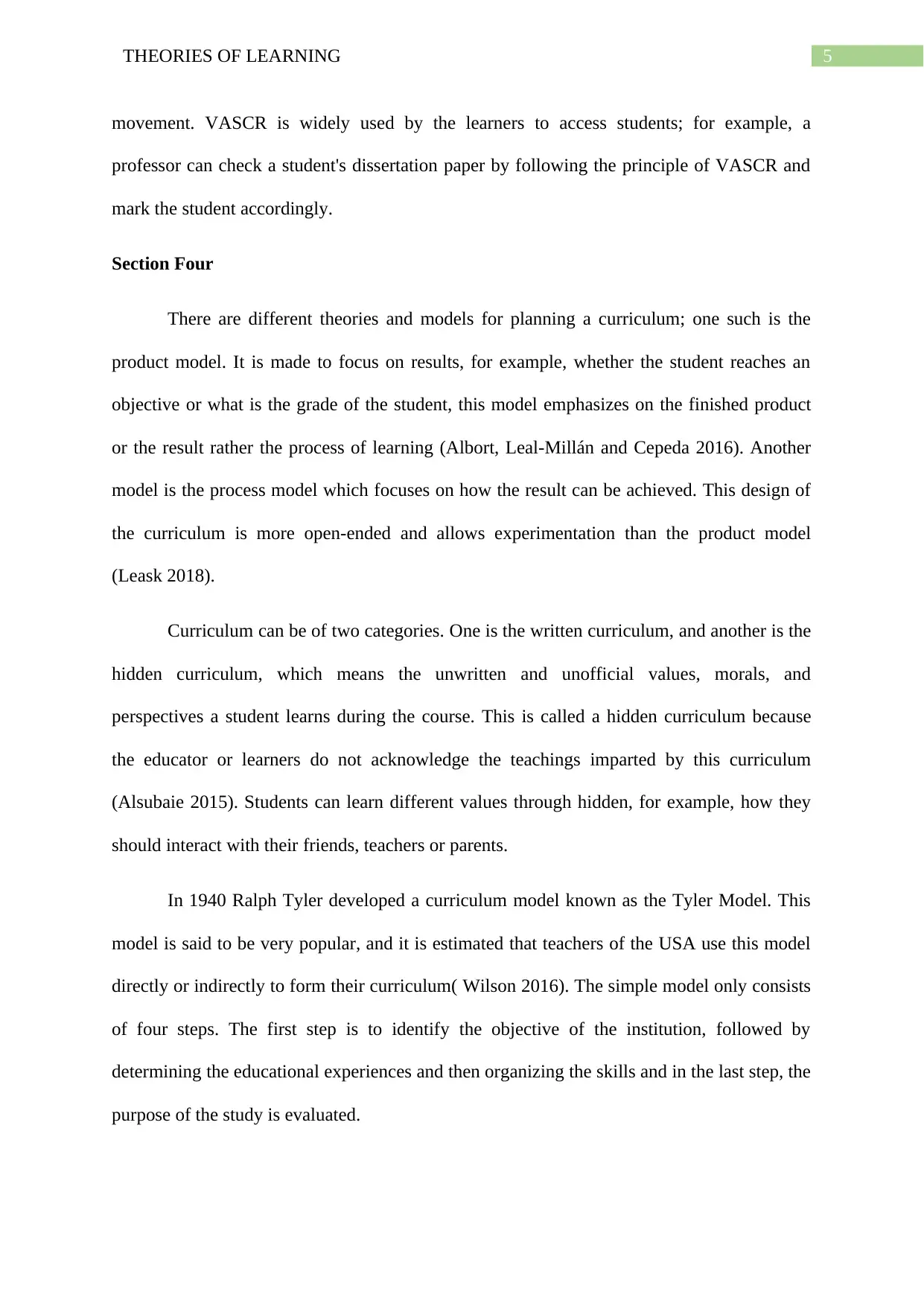
5THEORIES OF LEARNING
movement. VASCR is widely used by the learners to access students; for example, a
professor can check a student's dissertation paper by following the principle of VASCR and
mark the student accordingly.
Section Four
There are different theories and models for planning a curriculum; one such is the
product model. It is made to focus on results, for example, whether the student reaches an
objective or what is the grade of the student, this model emphasizes on the finished product
or the result rather the process of learning (Albort, Leal-Millán and Cepeda 2016). Another
model is the process model which focuses on how the result can be achieved. This design of
the curriculum is more open-ended and allows experimentation than the product model
(Leask 2018).
Curriculum can be of two categories. One is the written curriculum, and another is the
hidden curriculum, which means the unwritten and unofficial values, morals, and
perspectives a student learns during the course. This is called a hidden curriculum because
the educator or learners do not acknowledge the teachings imparted by this curriculum
(Alsubaie 2015). Students can learn different values through hidden, for example, how they
should interact with their friends, teachers or parents.
In 1940 Ralph Tyler developed a curriculum model known as the Tyler Model. This
model is said to be very popular, and it is estimated that teachers of the USA use this model
directly or indirectly to form their curriculum( Wilson 2016). The simple model only consists
of four steps. The first step is to identify the objective of the institution, followed by
determining the educational experiences and then organizing the skills and in the last step, the
purpose of the study is evaluated.
movement. VASCR is widely used by the learners to access students; for example, a
professor can check a student's dissertation paper by following the principle of VASCR and
mark the student accordingly.
Section Four
There are different theories and models for planning a curriculum; one such is the
product model. It is made to focus on results, for example, whether the student reaches an
objective or what is the grade of the student, this model emphasizes on the finished product
or the result rather the process of learning (Albort, Leal-Millán and Cepeda 2016). Another
model is the process model which focuses on how the result can be achieved. This design of
the curriculum is more open-ended and allows experimentation than the product model
(Leask 2018).
Curriculum can be of two categories. One is the written curriculum, and another is the
hidden curriculum, which means the unwritten and unofficial values, morals, and
perspectives a student learns during the course. This is called a hidden curriculum because
the educator or learners do not acknowledge the teachings imparted by this curriculum
(Alsubaie 2015). Students can learn different values through hidden, for example, how they
should interact with their friends, teachers or parents.
In 1940 Ralph Tyler developed a curriculum model known as the Tyler Model. This
model is said to be very popular, and it is estimated that teachers of the USA use this model
directly or indirectly to form their curriculum( Wilson 2016). The simple model only consists
of four steps. The first step is to identify the objective of the institution, followed by
determining the educational experiences and then organizing the skills and in the last step, the
purpose of the study is evaluated.
⊘ This is a preview!⊘
Do you want full access?
Subscribe today to unlock all pages.

Trusted by 1+ million students worldwide
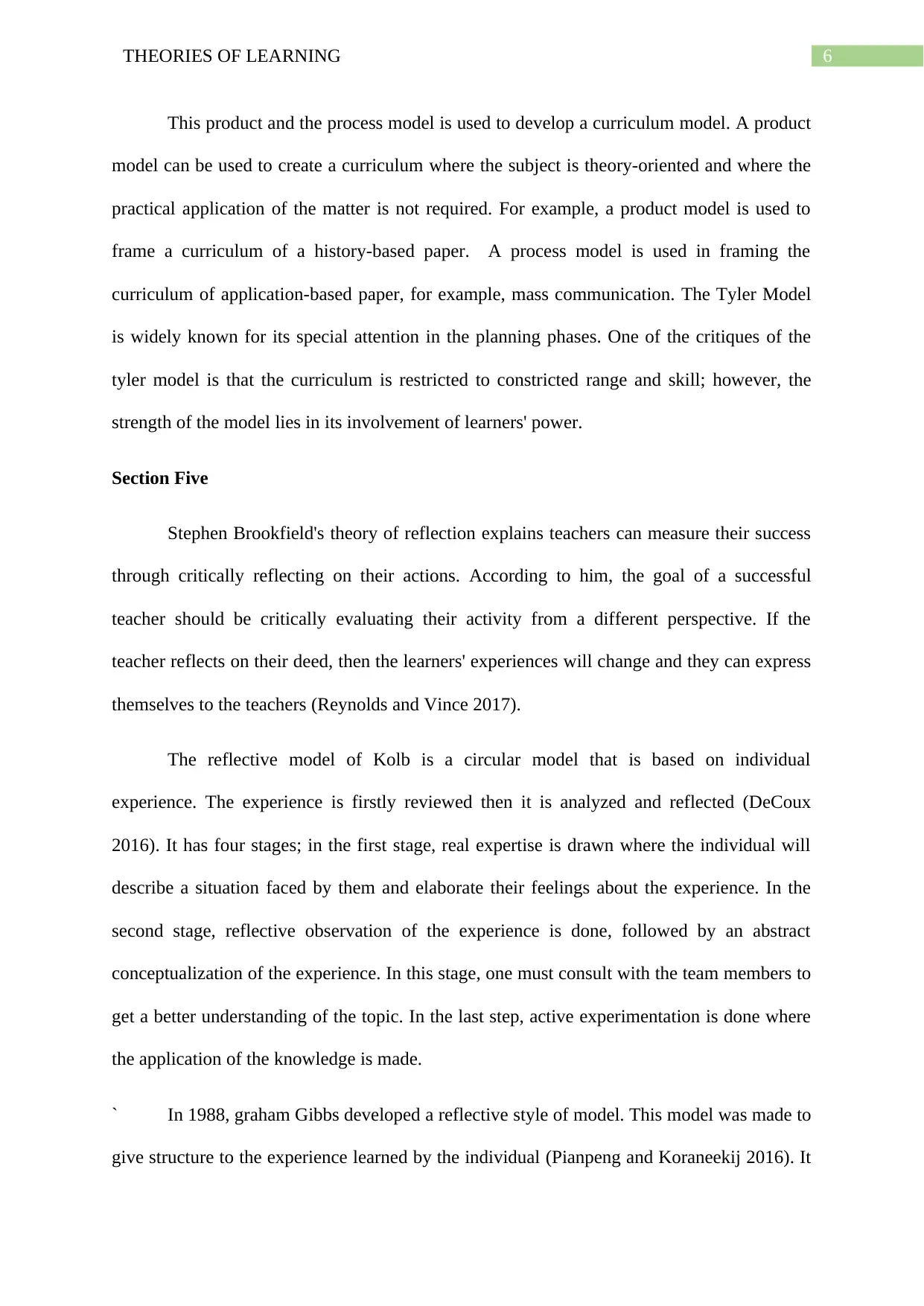
6THEORIES OF LEARNING
This product and the process model is used to develop a curriculum model. A product
model can be used to create a curriculum where the subject is theory-oriented and where the
practical application of the matter is not required. For example, a product model is used to
frame a curriculum of a history-based paper. A process model is used in framing the
curriculum of application-based paper, for example, mass communication. The Tyler Model
is widely known for its special attention in the planning phases. One of the critiques of the
tyler model is that the curriculum is restricted to constricted range and skill; however, the
strength of the model lies in its involvement of learners' power.
Section Five
Stephen Brookfield's theory of reflection explains teachers can measure their success
through critically reflecting on their actions. According to him, the goal of a successful
teacher should be critically evaluating their activity from a different perspective. If the
teacher reflects on their deed, then the learners' experiences will change and they can express
themselves to the teachers (Reynolds and Vince 2017).
The reflective model of Kolb is a circular model that is based on individual
experience. The experience is firstly reviewed then it is analyzed and reflected (DeCoux
2016). It has four stages; in the first stage, real expertise is drawn where the individual will
describe a situation faced by them and elaborate their feelings about the experience. In the
second stage, reflective observation of the experience is done, followed by an abstract
conceptualization of the experience. In this stage, one must consult with the team members to
get a better understanding of the topic. In the last step, active experimentation is done where
the application of the knowledge is made.
` In 1988, graham Gibbs developed a reflective style of model. This model was made to
give structure to the experience learned by the individual (Pianpeng and Koraneekij 2016). It
This product and the process model is used to develop a curriculum model. A product
model can be used to create a curriculum where the subject is theory-oriented and where the
practical application of the matter is not required. For example, a product model is used to
frame a curriculum of a history-based paper. A process model is used in framing the
curriculum of application-based paper, for example, mass communication. The Tyler Model
is widely known for its special attention in the planning phases. One of the critiques of the
tyler model is that the curriculum is restricted to constricted range and skill; however, the
strength of the model lies in its involvement of learners' power.
Section Five
Stephen Brookfield's theory of reflection explains teachers can measure their success
through critically reflecting on their actions. According to him, the goal of a successful
teacher should be critically evaluating their activity from a different perspective. If the
teacher reflects on their deed, then the learners' experiences will change and they can express
themselves to the teachers (Reynolds and Vince 2017).
The reflective model of Kolb is a circular model that is based on individual
experience. The experience is firstly reviewed then it is analyzed and reflected (DeCoux
2016). It has four stages; in the first stage, real expertise is drawn where the individual will
describe a situation faced by them and elaborate their feelings about the experience. In the
second stage, reflective observation of the experience is done, followed by an abstract
conceptualization of the experience. In this stage, one must consult with the team members to
get a better understanding of the topic. In the last step, active experimentation is done where
the application of the knowledge is made.
` In 1988, graham Gibbs developed a reflective style of model. This model was made to
give structure to the experience learned by the individual (Pianpeng and Koraneekij 2016). It
Paraphrase This Document
Need a fresh take? Get an instant paraphrase of this document with our AI Paraphraser
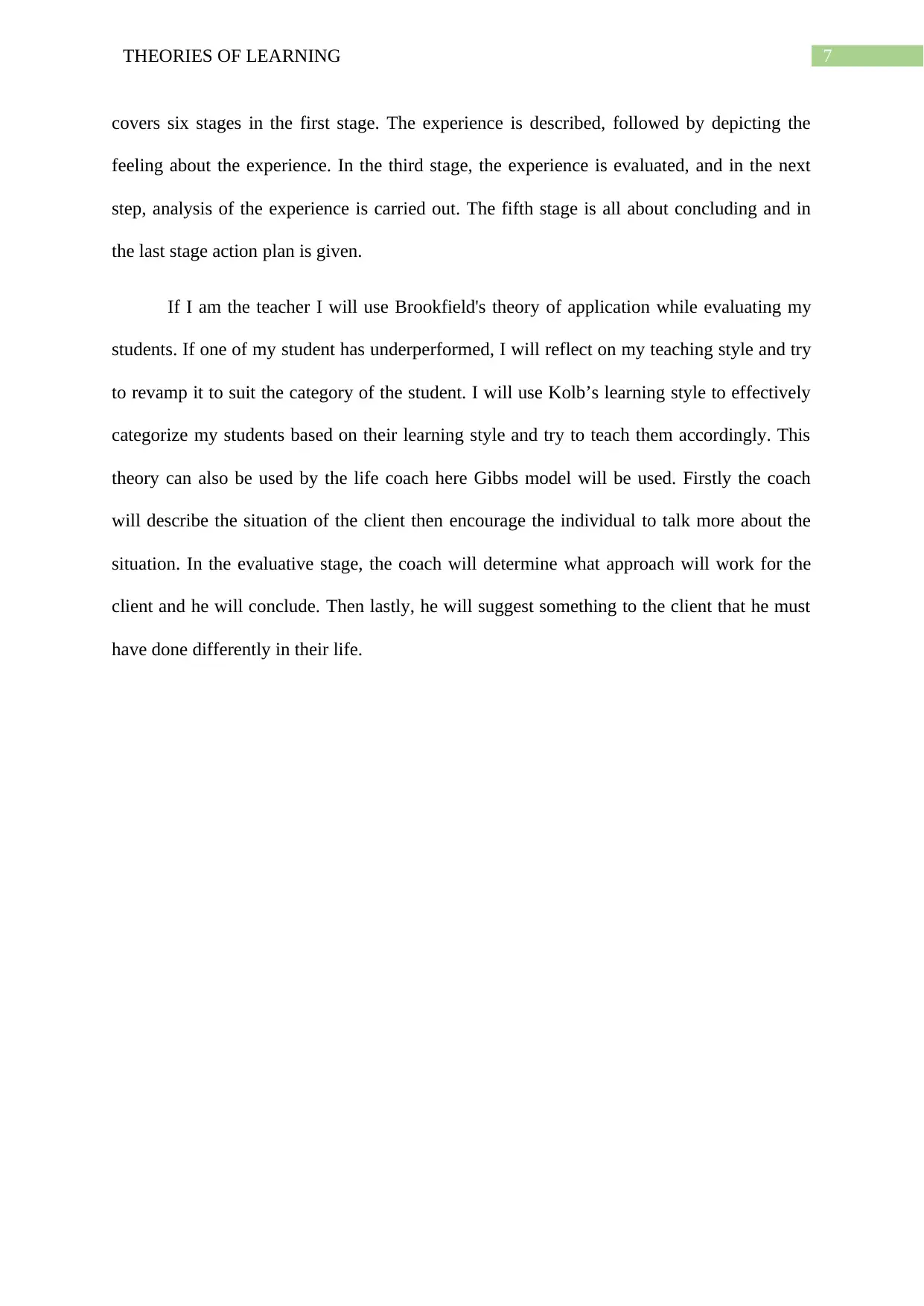
7THEORIES OF LEARNING
covers six stages in the first stage. The experience is described, followed by depicting the
feeling about the experience. In the third stage, the experience is evaluated, and in the next
step, analysis of the experience is carried out. The fifth stage is all about concluding and in
the last stage action plan is given.
If I am the teacher I will use Brookfield's theory of application while evaluating my
students. If one of my student has underperformed, I will reflect on my teaching style and try
to revamp it to suit the category of the student. I will use Kolb’s learning style to effectively
categorize my students based on their learning style and try to teach them accordingly. This
theory can also be used by the life coach here Gibbs model will be used. Firstly the coach
will describe the situation of the client then encourage the individual to talk more about the
situation. In the evaluative stage, the coach will determine what approach will work for the
client and he will conclude. Then lastly, he will suggest something to the client that he must
have done differently in their life.
covers six stages in the first stage. The experience is described, followed by depicting the
feeling about the experience. In the third stage, the experience is evaluated, and in the next
step, analysis of the experience is carried out. The fifth stage is all about concluding and in
the last stage action plan is given.
If I am the teacher I will use Brookfield's theory of application while evaluating my
students. If one of my student has underperformed, I will reflect on my teaching style and try
to revamp it to suit the category of the student. I will use Kolb’s learning style to effectively
categorize my students based on their learning style and try to teach them accordingly. This
theory can also be used by the life coach here Gibbs model will be used. Firstly the coach
will describe the situation of the client then encourage the individual to talk more about the
situation. In the evaluative stage, the coach will determine what approach will work for the
client and he will conclude. Then lastly, he will suggest something to the client that he must
have done differently in their life.
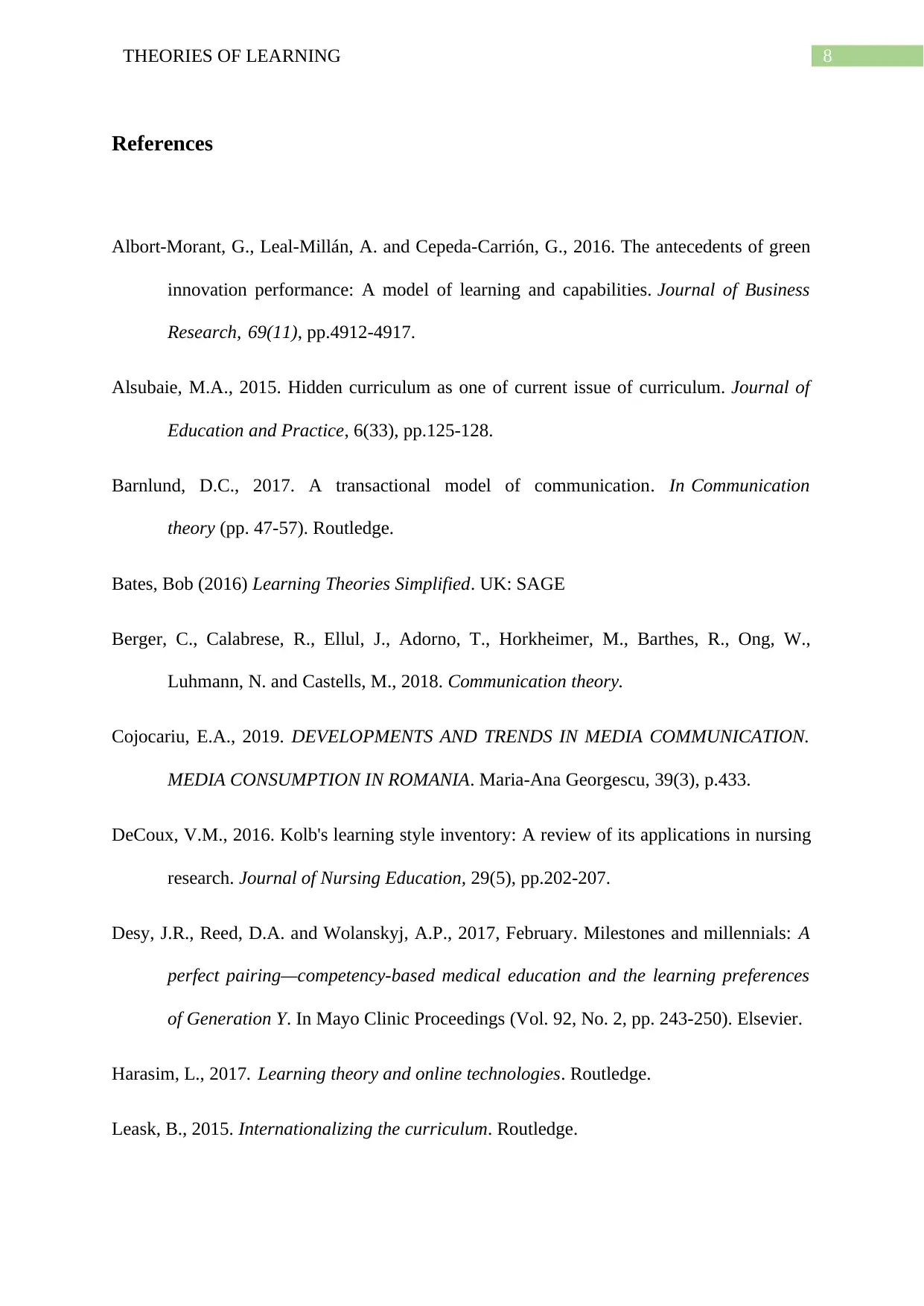
8THEORIES OF LEARNING
References
Albort-Morant, G., Leal-Millán, A. and Cepeda-Carrión, G., 2016. The antecedents of green
innovation performance: A model of learning and capabilities. Journal of Business
Research, 69(11), pp.4912-4917.
Alsubaie, M.A., 2015. Hidden curriculum as one of current issue of curriculum. Journal of
Education and Practice, 6(33), pp.125-128.
Barnlund, D.C., 2017. A transactional model of communication. In Communication
theory (pp. 47-57). Routledge.
Bates, Bob (2016) Learning Theories Simplified. UK: SAGE
Berger, C., Calabrese, R., Ellul, J., Adorno, T., Horkheimer, M., Barthes, R., Ong, W.,
Luhmann, N. and Castells, M., 2018. Communication theory.
Cojocariu, E.A., 2019. DEVELOPMENTS AND TRENDS IN MEDIA COMMUNICATION.
MEDIA CONSUMPTION IN ROMANIA. Maria-Ana Georgescu, 39(3), p.433.
DeCoux, V.M., 2016. Kolb's learning style inventory: A review of its applications in nursing
research. Journal of Nursing Education, 29(5), pp.202-207.
Desy, J.R., Reed, D.A. and Wolanskyj, A.P., 2017, February. Milestones and millennials: A
perfect pairing—competency-based medical education and the learning preferences
of Generation Y. In Mayo Clinic Proceedings (Vol. 92, No. 2, pp. 243-250). Elsevier.
Harasim, L., 2017. Learning theory and online technologies. Routledge.
Leask, B., 2015. Internationalizing the curriculum. Routledge.
References
Albort-Morant, G., Leal-Millán, A. and Cepeda-Carrión, G., 2016. The antecedents of green
innovation performance: A model of learning and capabilities. Journal of Business
Research, 69(11), pp.4912-4917.
Alsubaie, M.A., 2015. Hidden curriculum as one of current issue of curriculum. Journal of
Education and Practice, 6(33), pp.125-128.
Barnlund, D.C., 2017. A transactional model of communication. In Communication
theory (pp. 47-57). Routledge.
Bates, Bob (2016) Learning Theories Simplified. UK: SAGE
Berger, C., Calabrese, R., Ellul, J., Adorno, T., Horkheimer, M., Barthes, R., Ong, W.,
Luhmann, N. and Castells, M., 2018. Communication theory.
Cojocariu, E.A., 2019. DEVELOPMENTS AND TRENDS IN MEDIA COMMUNICATION.
MEDIA CONSUMPTION IN ROMANIA. Maria-Ana Georgescu, 39(3), p.433.
DeCoux, V.M., 2016. Kolb's learning style inventory: A review of its applications in nursing
research. Journal of Nursing Education, 29(5), pp.202-207.
Desy, J.R., Reed, D.A. and Wolanskyj, A.P., 2017, February. Milestones and millennials: A
perfect pairing—competency-based medical education and the learning preferences
of Generation Y. In Mayo Clinic Proceedings (Vol. 92, No. 2, pp. 243-250). Elsevier.
Harasim, L., 2017. Learning theory and online technologies. Routledge.
Leask, B., 2015. Internationalizing the curriculum. Routledge.
⊘ This is a preview!⊘
Do you want full access?
Subscribe today to unlock all pages.

Trusted by 1+ million students worldwide
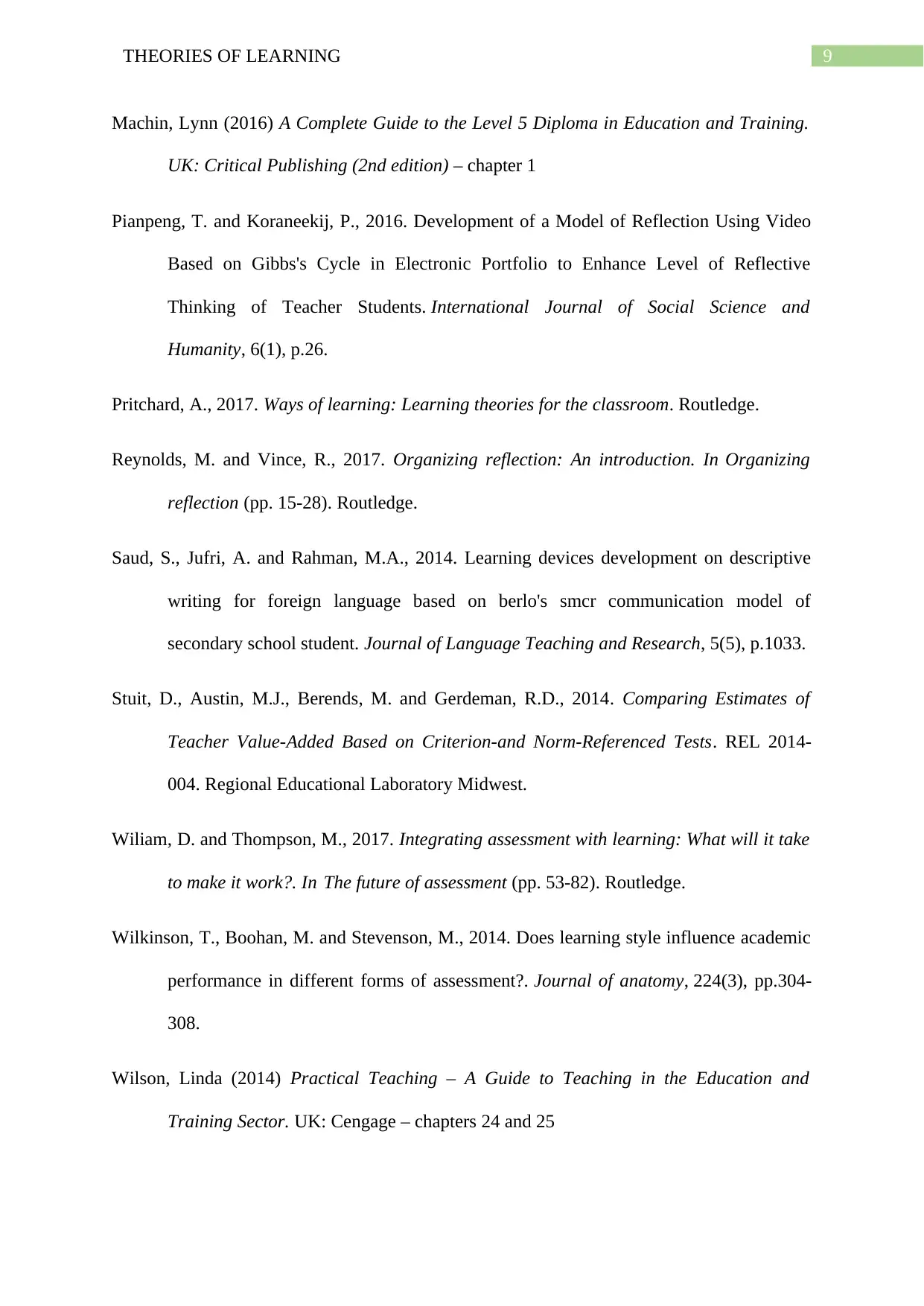
9THEORIES OF LEARNING
Machin, Lynn (2016) A Complete Guide to the Level 5 Diploma in Education and Training.
UK: Critical Publishing (2nd edition) – chapter 1
Pianpeng, T. and Koraneekij, P., 2016. Development of a Model of Reflection Using Video
Based on Gibbs's Cycle in Electronic Portfolio to Enhance Level of Reflective
Thinking of Teacher Students. International Journal of Social Science and
Humanity, 6(1), p.26.
Pritchard, A., 2017. Ways of learning: Learning theories for the classroom. Routledge.
Reynolds, M. and Vince, R., 2017. Organizing reflection: An introduction. In Organizing
reflection (pp. 15-28). Routledge.
Saud, S., Jufri, A. and Rahman, M.A., 2014. Learning devices development on descriptive
writing for foreign language based on berlo's smcr communication model of
secondary school student. Journal of Language Teaching and Research, 5(5), p.1033.
Stuit, D., Austin, M.J., Berends, M. and Gerdeman, R.D., 2014. Comparing Estimates of
Teacher Value-Added Based on Criterion-and Norm-Referenced Tests. REL 2014-
004. Regional Educational Laboratory Midwest.
Wiliam, D. and Thompson, M., 2017. Integrating assessment with learning: What will it take
to make it work?. In The future of assessment (pp. 53-82). Routledge.
Wilkinson, T., Boohan, M. and Stevenson, M., 2014. Does learning style influence academic
performance in different forms of assessment?. Journal of anatomy, 224(3), pp.304-
308.
Wilson, Linda (2014) Practical Teaching – A Guide to Teaching in the Education and
Training Sector. UK: Cengage – chapters 24 and 25
Machin, Lynn (2016) A Complete Guide to the Level 5 Diploma in Education and Training.
UK: Critical Publishing (2nd edition) – chapter 1
Pianpeng, T. and Koraneekij, P., 2016. Development of a Model of Reflection Using Video
Based on Gibbs's Cycle in Electronic Portfolio to Enhance Level of Reflective
Thinking of Teacher Students. International Journal of Social Science and
Humanity, 6(1), p.26.
Pritchard, A., 2017. Ways of learning: Learning theories for the classroom. Routledge.
Reynolds, M. and Vince, R., 2017. Organizing reflection: An introduction. In Organizing
reflection (pp. 15-28). Routledge.
Saud, S., Jufri, A. and Rahman, M.A., 2014. Learning devices development on descriptive
writing for foreign language based on berlo's smcr communication model of
secondary school student. Journal of Language Teaching and Research, 5(5), p.1033.
Stuit, D., Austin, M.J., Berends, M. and Gerdeman, R.D., 2014. Comparing Estimates of
Teacher Value-Added Based on Criterion-and Norm-Referenced Tests. REL 2014-
004. Regional Educational Laboratory Midwest.
Wiliam, D. and Thompson, M., 2017. Integrating assessment with learning: What will it take
to make it work?. In The future of assessment (pp. 53-82). Routledge.
Wilkinson, T., Boohan, M. and Stevenson, M., 2014. Does learning style influence academic
performance in different forms of assessment?. Journal of anatomy, 224(3), pp.304-
308.
Wilson, Linda (2014) Practical Teaching – A Guide to Teaching in the Education and
Training Sector. UK: Cengage – chapters 24 and 25
1 out of 10
Related Documents
Your All-in-One AI-Powered Toolkit for Academic Success.
+13062052269
info@desklib.com
Available 24*7 on WhatsApp / Email
![[object Object]](/_next/static/media/star-bottom.7253800d.svg)
Unlock your academic potential
Copyright © 2020–2025 A2Z Services. All Rights Reserved. Developed and managed by ZUCOL.





